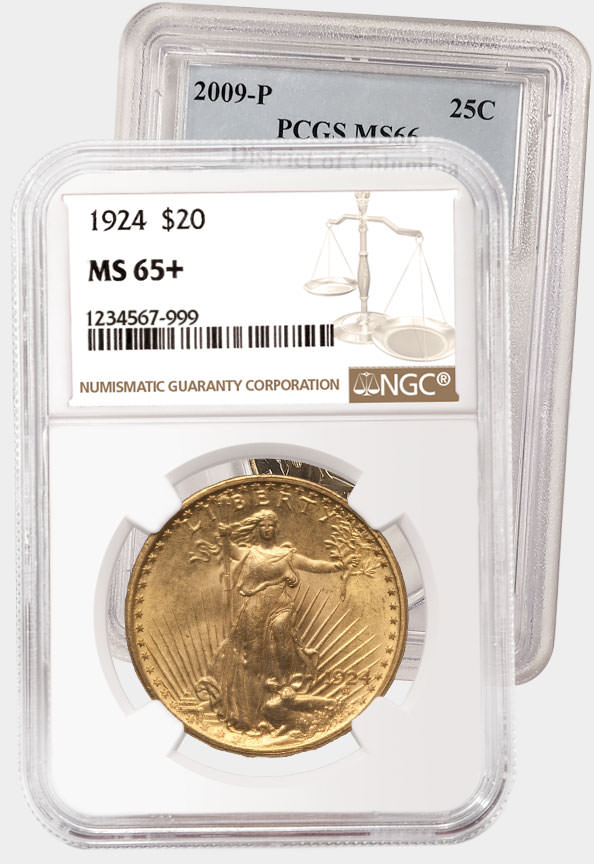NGC Ancients: Pegasus on Ancient Greek Coins
Posted on 10/11/2022
By
Ben Wallace
NGC Ancients Grader
The story of the winged-horse Pegasus would be known to anyone familiar with ancient Greek mythology. It was a popular story among both the Greeks and Romans and this mighty steed continues to spark our imaginations today. This month we’ll learn about the legend of Pegasus and review some of the beautiful coins featuring this majestic animal.
 |
The detail on this electrum stater of c.500-450 B.C. is truly breathtaking. This coin was made in the city of Lampsacus in Mysia, located in the northern part of modern Turkey. The obverse shows the forepart of Pegasus and a grapevine along the border. The reverse has a quadripartite incuse.
The story of Pegasus goes back to at least the 8th century B.C., where he appears in poetry. Pegasus was born of the blood spilled when the hero Perseus cut off the head of the hideous gorgon Medusa. He was a wild horse and was known for his power to create springs wherever he struck his hoof.
His most famous stories were tied to the Greek hero Bellerophon. Bellerophon was able to tame Pegasus with help from the goddess Athena. The duo became famous when they slew the Chimera, a fire-breathing lion with a goat head on its back and a snake tail.
 |
Depicting this mythological episode is the bronze shown above, made at the city of Leucas around 350-300 B.C. Bellerophon wields a spear while riding Pegasus, and the reverse shows the Chimera in all its oddly proportioned glory.
With this increase in fame, Bellerophon’s arrogance grew. Since he felt he was worthy to live with the gods on Mount Olympus, he flew Pegasus toward the mountain peak. This angered the gods and caused Zeus to send a fly to sting Pegasus, who then threw off Bellerophon and continued onto Olympus.
Once there, Zeus put Pegasus to work carrying the gods' thunderbolts around. After years of faithful service, Zeus rewarded Pegasus by transforming him into a constellation, one that we still recognize today.
 |
The silver trishekel above was made by the Carthaginians in Sicily around c.264-241 B.C. The obverse shows the Carthaginian goddess Tanit. The reverse features an amazing Pegasus in flight. With its strong muscles and well-detailed wings, the animal feels as if it’s about to leap off the flan.
 |
The city of Corinth, located on the northern shore of the Greek Peloponnese used Pegasus on much of its coinage. In legend, Bellerophon was the hero and king of Corinth. The silver stater above was made c.550-500 B.C. and shows an archaic-style Pegasus in flight. The reverse has an incuse punch.
 |
The stater above was also made at Corinth, but at a later time, c.400-375 B.C. It shows a beautiful Pegasus in flight, opposite the helmeted bust of Athena and a two-bodied owl.
As a former king of Corinth, Bellerophon's story was important to its people and they used Pegasus on their coinage to pay homage. Equally honored on most Corinthian staters is the goddess Athena, who originally gave Bellerophon the golden bridle he used to capture Pegasus.
 |
The stater above is magnificent in every respect. Minted at Syracuse, the foremost city of Sicily, around 344-337 B.C., it shows a highly detailed bust of Zeus Eleutherios and a majestic Pegasus in flight.
Zeus Eleutherios means “Zeus the Liberator.” This coin was made during a time of strife and war in Syracuse, when the people overthrew the despotic rulers of their city. It would appear that this coin pays homage to Zeus in the hope he would liberate them.
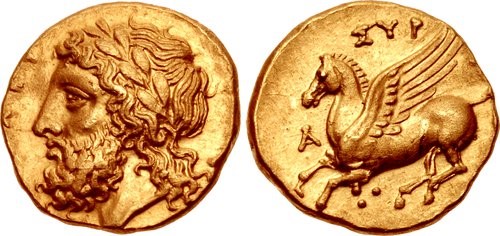 |
This beautiful gold 30 Litrai (or hemidrachm) was also made at Syracuse around 344-317 B.C. Zeus Eleutherios is portrayed on the obverse in a similarly pleasant style. The reverse shows Pegasus flying left.
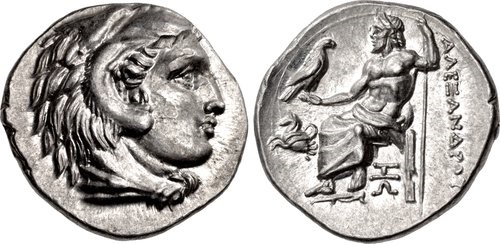 |
Not all coins portraying Pegasus have him as a main subject. One example is this silver drachm made at Abydus for the Macedonian King Alexander III ‘the Great’ (336-323 B.C.). The obverse shows the hero Heracles (Hercules) wearing a lion headdress. The reverse shows Zeus holding an eagle, with a small Pegasus before his knee as a mint symbol.
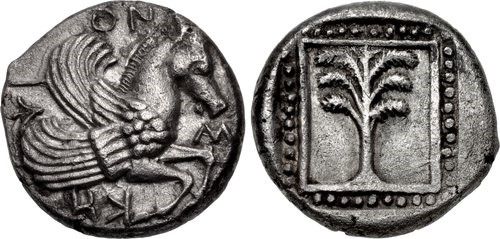 |
Made at the city of Scepsis in Troas during the 5th Century B.C., the above silver drachm shows the forepart of Pegasus on the obverse. The reverse shows a palm tree within a square and pellets.
 |
The gorgeous electrum stater above was made at an uncertain mint in the region of Mysia during the 5th or 4th century B.C. The obverse shows the forepart of Pegasus in flight with a spearhead below. The reverse has a simple quadripartite incuse.
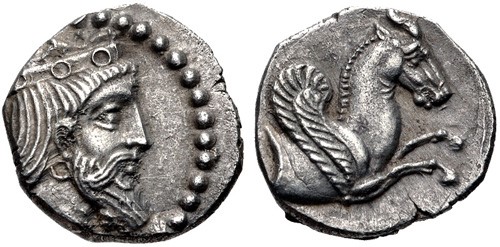 |
This silver obol is merely 9mm in diameter, but is packed with detail. Made at an unknown mint in Cilicia during the 4th century B.C., it shows a crowned and bearded head opposite the forepart of Pegasus in flight.
 |
The scarce tetradrachm above was made in the city of Alabanda in c.167/166 B.C. This city was located on the Western coast of modern-day Turkey. The obverse features a bust of the god Apollo, and the reverse shows Pegasus rearing, perhaps about to take flight.
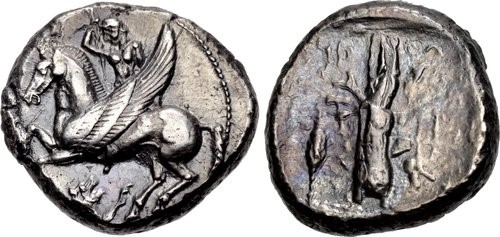 |
Made c.440-420 B.C. at the city of Tarsus in Cilicia, this silver stater depicts the famous battle against the Chimera. On the obverse we see Bellerophon riding Pegasus and preparing to cast a spear downward into the Chimera. The reverse shows the Mesopotamian god Nergal raising one hand and holding an axe in the other. Next to the god is a grain ear and small tree.
 |
We’ll end our survey with one of the more unusual coins made to honor Pegasus. Minted c.360-338 B.C. at Ambracia in Northwestern Greece, this stater shows Pegasus and Bellerophon. This time, however, the pair is shown in a more relaxed setting with the Greek hero examining Pegasus’s hoof. The reverse shows the goddess Athena wearing a Corinthian helmet.
Images courtesy of Classical Numismatic Group and Heritage Auctions.
Stay Informed
Want news like this delivered to your inbox once a month? Subscribe to the free NGC eNewsletter today!
